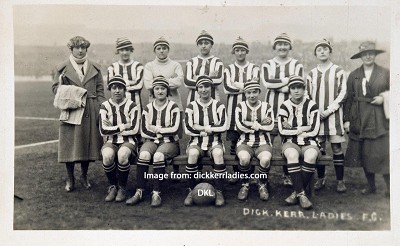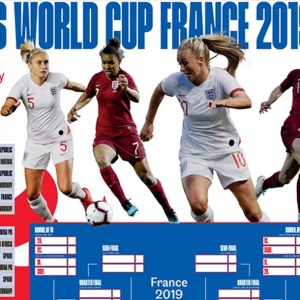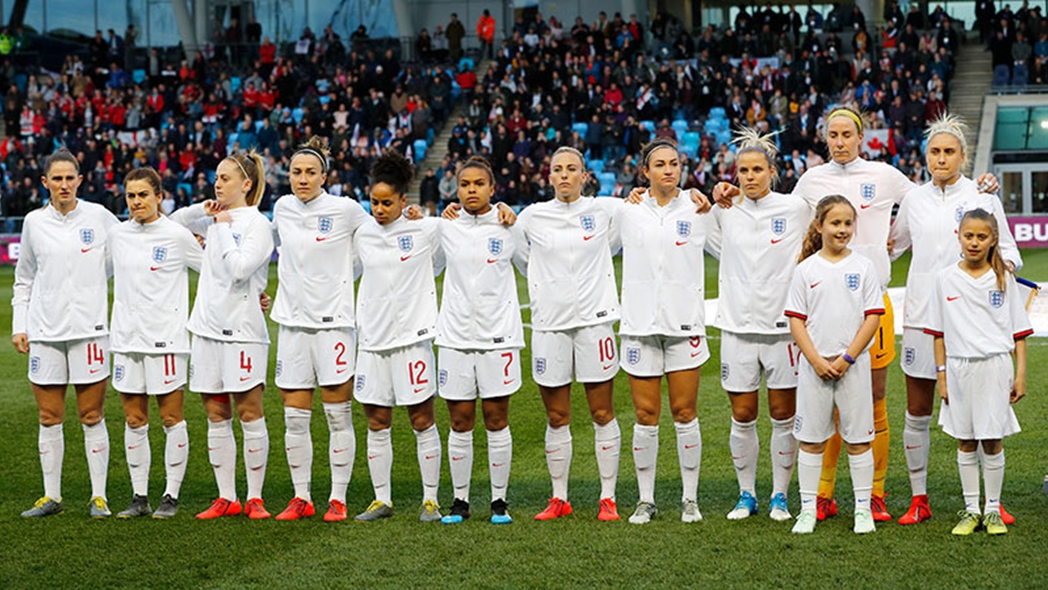The 23 players who have the honour of representing England at the FIFA Women's World Cup 2019 TM in France
(Source: http://www.thefa.com/news/2019/may/08/world-cup-england-squad-080519)
As the FIFA Women's World Cup 2019 TM kicks off today, I wanted to pay tribute to the women in whose footsteps our Lionesses follow, and every other women who is involved in this tournament.
It's not been an easy journey for women to get to this point, and it has taken centuries to arrive at this stage. The journey has been punctuated with three different eras, all clearly defined by the women’s commitment to reclaiming the game in the face of ridicule and injustice which included a 50-year ban by the Football Assocation (FA).
My interest in this is also personal, as my daughter started to play football as a child at an Inclusive Play and Childcare scheme I opened in Bolton within our Bolton Wanderers Football in the Community sessions in the school holidays. My daughter went on to play for what was then Bolton Wanderers Ladies, so I have first-hand experience of the uphill battle girls and women still face and the so called grass-ceiling they are constantly fighting against.
If the friendly match at Brighton between England and New Zealand on June 1 is anything to go by, with an attendance of over 20,000 people, it's going to be a fantastic tournament! When the first kick is taken, it will be a good time to reflect on the journey so far and plan for a brighter future for those whose footsteps are yet to come.
The very first evidence of women’s football can be traced as far back as the Han Dynasty (206 B.C.—220 A.D.). As a sport, it was so popular that Cuju as it was known, is featured in an ancient text depicting the splendid scene of a women’s match involving 153 people. The ladies, wearing four colors of embroidered silk clothing and sashes, played for an audience of tens of thousands.
In the UK, the earliest record of Women’s football was in Scotland in the 18th Century - at that time it was all part of the process for choosing a prospective bride!
In England the game was predominantly a male bastion, particularly within public schools. The FA, English football’s governing body, was formed in 1863 and the Football League in 1885. That summer, football became a professional sport with the very first league being contested in 1888 by just 12 clubs. Over time, the FA raised the admission fee to a level which excluded the lower classes.
A women’s role in the game in England had been seen largely as a calming influence during the game - not on the pitch, but within the crowds, to be placed strategically with the hope of stopping the violent behaviour from opposing teams. In 1885 in Preston North End, free entry to games was given to all women. The take up of these free entries by women was overwhelming, yet sadly in response to this huge popularity, it was discontinued in the 1890’s.
The earliest record of the formalisation of women’s football is 1894, when Nettie Honeyball founded the British Ladies Football Club. It was governed by early femminist Florence Dixie and other emerging feminists of the time. The first match in this newly formed organisation was played in 1895 in Crouch End, London on the 23rd March.
Press coverage varied in 1895 and other than the Sportsman, who pointed to equity in skill and commitment to winning the game, all the media ridiculed the women's game.
Disappointingly, the perspective of the overriding male establishments was one of dismissal, with the British Medical Journal notably writing, "We can in no way sanction the reckless exposure to violence of organs, which the common experience of women had led them in every way to protect."
The irony of this was that the women’s game at the time had been raising money for medical charities.
In 1895 at Preston Park, as the game grew in gate numbers and skill, the press concentrated not on the skill of the players but on their gender, often mocking their attire. Despite all the attempts of Honeyball, Dixie and other considered feminists, the first recorded attempt to formalise and bring the women’s game to the masses failed.
There ended the first era.
We next see an emergence of the women’s game during the First World War, when women had taken up many of the roles previously occupied by men who had been called away to war. There were over 200,000 women in clerical roles, over a quarter of a million who worked the land, and over 700,000 in engineering jobs including munitions.
Interestingly the game re-emerged within the factories, often played at lunchtimes and once again a league was formed with the first official game being played in 1916.
The games were encouraged by the government at that time, more so after conscription in 1916. As the game grew in popularity so did the charitable endeavours of the women through the gate fees.
The most notable advancement of the women's game at this time came via the Dick Kerr Factory in Preston, supported by Alfred Frankland and Grace Sibbert, who became the manager of the Dick, Kerr Ladies Football Team. The first official gate figures exceeded 10,000 and raised over 200 pounds - an incredible amount at the time - for hospital charities. It continued at this level throughout the war, and saw an emergence of talent from women such as Alice Woods and Lilly Parr. The latter was considered to be the most skillful player in the history of the game. The game maintained its growth in gate fees, charitable donations and the laying of remembrance wreaths prior to the games themselves.

Alfred encouraged international growth in the game and in 1920 Federation des Societies Feminine Sportives de France sent a team to tour England. Madame Milliat, the founder, was a great advocate of women playing football. In response to the continued objection and ridicule of the women’s game, she was notably quoted as saying, “In my opinion, football is not wrong for women. Most of these girls are beautiful Grecian dancers. I do not think it is unwomanly to play football as they do not play like men, they play fast, but not vigorous football".
This unofficial international tournament continued to grow in popularity, increasing not only the women’s footprint in the game but also the gate fees and charitable giving.
On 26th December 1920, Dick, Kerr Ladies played the second best women's team in England, St Helens Ladies, at Goodison Park, the home ground of Everton. The plan was to raise money for the Unemployed Ex Servicemens Distress Fund in Liverpool. Over 53,000 people watched the game with an estimated 14,000 disappointed fans locked outside. It was the largest crowd that had ever watched a woman's game in England.
In 1921 the Dick, Kerr Ladies team was in such demand that having refused 120 invitations in the UK, went on to play 67 games watched by 900,000 people.
It is worth noting that then as well as now, most women players held down full time jobs as well. Alice Norris, a player at the time referred to how difficult that was.
A constant theme throughout the women’s game was a commitment to raising money for charitable causes Dick, Kerr Ladies raised money for Unemployed Ex Servicemen's Distress Fund, local workers who were in financial difficulty and the mining industry during the recession after the war. As Barbara Jacobs pointed out in The Dick, Kerr's Ladies, "Women's football was associated with charity", and perhaps fell naturally into supporting the reduction of inequalities in other fields beyond the ones they played upon. Sadly this led to some seeing the game as politically motivated, especially when it started to fund work in this area undertaken by the Labour party and the Trade Unions.
It was no secret that the FA objected to what they saw as women’s involvement in politics - this was all happening when women had only just won a hard-fought battle for the right to vote.
Was this second era of reclaiming the game doomed to fail not by lack of interest, skill or gate fees but due to a calculated attempt to force women back into pre-war roles?
The FA began what is now recognised as a propaganda campaign against women’s football and those who supported it. We saw the emergence of unfounded medical justifications for stopping the women’s game, as Dr Elizabeth Sloan Chesser said at the time "There are physical reasons why the game is harmful to women. It is a rough game at any time, but it is much more harmful to women than men. They may receive injuries from which they may never recover." Dr Mary Scharlieb, a Harley Street Physician added her own thoughts to the arguement, "I consider it a most unsuitable game, too much for a woman's physical frame."
Despite conflicting medical positions on the argument, when Dr Mary Lowry was invited to a Dick, Kerr Ladies match, she commented that, "From what I saw, football is no more likely to cause injuries to women than a heavy day's washing".
On 5th December 1921, the FA issued the following statement:
"Complaints having been made as to football being played by women, the Council feel impelled to express their strong opinion that the game of football is quite unsuitable for females and ought not to be encouraged.
Complaints have been made as to the conditions under which some of these matches have been arranged and played, and the appropriation of the receipts to other than Charitable objects.
The Council are further of the opinion that an excessive proportion of the receipts are absorbed in expenses and an inadequate percentage devoted to Charitable objects.
For these reasons the Council requests the clubs belonging to the Association refuse the use of their grounds for such matches.'
This effectively removed the ability of women to raise significant amounts of money for charity, as they were now barred from playing at all the major venues. They also prevented members from being referees or linesmen at a women’s game.
In response to the situation in their own country the Dick, Kerr Ladies were taken on an International tour tour of Canada and the United States by Alfred Frankland. Sadly they faced similar bans in Canada but were allowed to play in Boston, Baltimore, St. Louis, Washington, Detroit, Chicago and Philadelphia.
It's hard to imagine or justify the decision taken by the FA and the subsequent battles women and those who supported them faced as they fought the establishment for the right to play. These challenges, way too many to include in this piece, which were intended to decimate the professional women’s game, did just that. The game was never completely defeated, but as Ali Melling pointed out in Women and Football (2002), "The ban marked the start of a decline in the game, and during the 1920s and 1930s, ladies' football was reduced to a minor sub-culture."
The Ladies FA declined as a direct result of the ban.
At the time of this decline, Frankland made a speech where he claimed, "Since our inception we have played 437 matches, won 424, lost 7 and drawn 6, scored 2,863 goals and had only 207 scored against. We have raised over £100,000 in this country and in foreign lands for charity. We have won 14 silver cups, 5 of them outright, and hold a trophy awarded for the most meritorious assistance given to ex-servicemen."
Here endeth the second era.
Unsurprisingly though Women continued to fight the ban until it was rescinded in 1971 (yes 50 years later).
So as we see the first match of the FIFA World Cup played today, June 6, 2019, in what is termed to be the third era in which women are reclaiming the game, let us pay homage to the Women who fought so tirelessly to remove the ban in order that the game today could even go ahead. More importantly, let us build on this renewed interest in the women’s game. We can bring about real and sustainable changes to the inequalities which have led to the no-longer acceptable disparity within the men and women’s game, be it in terms of pay, facilities, overall investment in players and opportunities within the game.
One of the most significant moves forward in this area that I have seen is taking place within a Women’s Football Club in Lewes, within the Equality FC Campaign. Lewes FC is the first football club in the world to adopt an equal pay policy for both its men and women’s team: https://www.lewesfc.com/.
This initiative, whilst radical and will no doubt face the wrath of the establishment, is hitting the sexism that exists within the game head on, not with vengeance but with positive action. This will bring about the next era of reclaiming the game, where women are not playing a man's game but women’s football, which reflects the very essence of who we are.
 I was lucky enough to interview the Campaign Manager at the Club, Karen Dobres for a @FiLiA Podcast (https://filia.org.uk/podcasts/2019/6/7/filia-meets-karen-dobres) and it is fitting that the Podcast is released today at the start of the FIFA Women's World Cup 2019 TM in celebration of women players around the world.
I was lucky enough to interview the Campaign Manager at the Club, Karen Dobres for a @FiLiA Podcast (https://filia.org.uk/podcasts/2019/6/7/filia-meets-karen-dobres) and it is fitting that the Podcast is released today at the start of the FIFA Women's World Cup 2019 TM in celebration of women players around the world.
I wish all the teams luck as they run onto the pitch to show skill and talent, and that the game is here to stay !
#Lionesses #Football #Women #Inequality #AnInclusiveWorld #DickKerrLadiesTeam #Frankland #LewisFC #KarenDobres #England #Scotland #Ireland #Wales
References:
https://spartacus-educational.com/Fwomen.htm
http://www.thefa.com/england/womens-seniors/squad
http://www.thefa.com/news/2019/may/08/world-cup-england-squad-080519
https://filia.org.uk/podcasts/2019/6/7/filia-meets-karen-dobres



